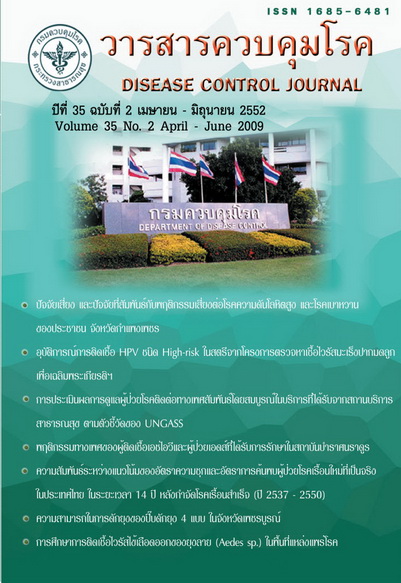Assessment of Service Activities Delivered to STI Case by Public Health Settings: An UNGASS Indicator Based Study
Keywords:
UNGASS indicator, Service Activities to STI Case, Health care settingsAbstract
According to UNGASS indicator, STI case management included history taking, case examination, case diagnosis, case treatment and counseling. The aim of this study was to determine whether these services provided by health care settings met the UNGASS indicator. Data were collected accordingly to ICD 10 from STI clients during January to December 2005. STI clinics from regional, provicial, comunity and private hospitals (42 hospitals and 601 STI cases) were selected and the data were processed during Jun-Sept 2006 to determine frequency, percentage and mean. The study demonstrated that majority of health care settings had no special STI separate clinic (71.43%), hence the male clients were served at general medicine clinic (60.53%) whilst female clients at OB-GYN clinic (53.85%). Only 28.57% of health care settings served under separate STI clinic and rendered service to female sex workers only and half day for once a week. STI clients who visited the health care settings was diagnosed and was undergone treatment, 78.87% were examined, 72.05% were history taken, and 40.60% received counseling service. In addition, the coverage of all expected service activities had been delivered to the clients in the proportion of 19.80%. In the aspect of health care settings, the proportion of the settings who served all of service activities were the community hospitals of less than 60 beds, private hospitals, community hospitals of more than 60 beds, general hospitals and central hospitals in 33.33%, 30.00% 29.73% 18.067% and 13.29% respectively. It was recommended the health care settings should aware of the importance of serving the clients all of STI case management activities by means of the current STI standing order guideline. The Office of Disease Prevention and Control incorporate with the Provincial Health Office should function as the core organizer for a training or a mutual cooperation between health care settings for enabling them to deliver such standard health care service whilst STIs Cluster should play a role to facilitate the technical point of view.
Downloads
References
2. Wisdom A and Hawkins DA.Interation between HIV and Sexually Transmitted Diseases. In; Wisdom A and Hawkins DA.Diagnosis in color Sexually Transmitted Diseases. Second edition. London: Mosby-Wolfe; 1997. 251-261
3. Sexually Transmitted infections: Briefing kit for teachers, World Health Organization. egional office for the western pacific. 2001
4. Cohen MS. Sexually Transmitted Diseases enhance HIV transmittion: no longer a hypothesis. Lancet. 1998; 351(Suppl 3): 5-7
5. แนวทางการสร้างตัวชี้วัดหลัก. การประชุมสมัชชาใหญ่ขององค์การสหประชาชาติสมัยพิเศษว่าด้วยเรื่องโรคเอดส์. การติดตามกำกับ ตามปฏิญญาว่าด้วยพันธกรณี เรื่องโรคเอดส์. กรุงเจนีวา ประเทศสวิสเซอแลนด์: กรกฎาคม ค.ศ.2005 (เอกสารสำเนาอัดโรเนียว)
6. กลุ่มโรคติดต่อทางเพศสัมพันธ์ สำนักโรคเอดส์ วัณโรค และโรคติดต่อทางเพศสัมพันธ์. รายงานผลการปฏิบัติงานควบคุมโรคติดต่อทางเพศสัมพันธ์ ปีงบประมาณ 2548. น.21, 19-20
7. ศูนย์ความร่วมมือไทย-สหรัฐด้านสาธารณสุข. Surveillance data on HIV infection among MSM in Thailand เอกสารประกอบการประชุมเชิงปฏิบัติการเพื่อเร่งรัดหามาตรการในการดำเนินงานป้องกันและแก้ไขปัญหาเอดส์ในกลุ่มชายรักชาย วันที่ 23 กันยายน 2548 ณ. ห้องประชุมชั้น 2 กรมควบคุมโรค กระทรวงสาธารณสุข.
8. กลุ่มโรคติดต่อทางเพศสัมพันธ์ สำนักโรคเอดส์ วัณโรค และโรคติดต่อทางเพศสัมพันธ์. คู่มือการดำเนินงานป้องกันควบคุมโรคติดเชื้อทางเพศสัมพันธ์ พ.ศ.2546 . พิมพ์ครั้งที่ 1. กรุงเทพฯ:โรงพิมพ์การศาสนา; กรกฎาคม 2546 . น. 46 - 50
9. กองกามโรค กรมควบคุมโรคติดต่อ. มาตรฐานการรักษาโรคติดต่อทางเพศสัมพันธ์ พ.ศ.2546. พิมพ์ครั้งที่ 5. กรุงเทพฯ: โรงพิมพ์ชุมนุมสหกรณ์การเกษตรแห่งประเทศไทย จำกัด; พ.ศ. 2548. น. 1-4
Downloads
Published
How to Cite
Issue
Section
License
Articles published in the Disease Control Journal are considered as academic work, research or analysis of the personal opinion of the authors, not the opinion of the Thailand Department of Disease Control or editorial team. The authors must be responsible for their articles.


.png)



